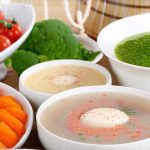Prebiotic-rich foods are increasingly recognized for their profound impact on gut health, offering benefits far beyond simple digestion. These undigestible fibers serve as nourishment for beneficial bacteria residing in our large intestine, fostering a thriving microbiome that’s linked to everything from immunity and mental well-being to nutrient absorption and chronic disease prevention. However, simply eating prebiotic foods isn’t enough; how we prepare them significantly influences their digestibility and the extent to which these benefits are realized. The human digestive system is complex, and different cooking methods can either enhance or hinder the availability of prebiotics for microbial fermentation.
Understanding this interplay between culinary techniques and prebiotic functionality is crucial for maximizing the health advantages of foods like onions, garlic, asparagus, bananas, oats, and many others. It’s not about eliminating cooking altogether – indeed, some methods are incredibly helpful! Instead, it’s about being mindful of how heat, water, and processing impact these delicate compounds. This article will delve into how common cooking methods affect the digestibility of prebiotic-rich foods, offering insights to help you make informed choices in the kitchen that support a healthier gut microbiome.
The Impact of Heat & Moisture on Prebiotic Structures
Heat and moisture are two of the most significant factors influencing prebiotic structures within food. Many prebiotics, such as inulin found abundantly in onions and garlic, are carbohydrate polymers – long chains of sugar molecules. These chains are relatively stable at room temperature but become more vulnerable to breakdown with exposure to heat and water. The degree of this breakdown depends heavily on the method used.
Boiling vegetables, for instance, can leach out water-soluble prebiotics like inulin, reducing their overall content and potentially diminishing their prebiotic effect. This isn’t necessarily a bad thing; some individuals experience digestive discomfort from high amounts of inulin, so moderate reduction might be preferable. However, for those seeking maximum benefit, methods that minimize water exposure are ideal. Conversely, dry heat – such as roasting or baking – tends to preserve more of the original prebiotic content because it doesn’t involve significant leaching. The key is recognizing this trade-off: boiling makes foods softer and easier to digest in some ways but reduces prebiotic concentration; roasting maintains prebiotics but may require stronger chewing.
Furthermore, prolonged high heat can actually change the structure of certain prebiotics, rendering them less available for fermentation by gut bacteria. This isn’t necessarily destruction, but rather a modification that alters their digestibility. For example, intense frying might alter the molecular configuration of fructans in asparagus, making them harder for specific microbial communities to utilize effectively. It’s important to remember that prebiotics aren’t a single entity; they comprise diverse compounds with varying responses to different cooking methods.
Optimizing Prebiotic Availability Through Cooking Methods
Rather than avoiding cooking altogether, the goal is to optimize prebiotic availability through strategic method selection. Steaming presents a compelling alternative to boiling, as it uses less water and shorter cooking times, minimizing leaching of soluble fibers. The gentle heat also preserves more of the original structure. Similarly, stir-frying with minimal oil can quickly cook vegetables while retaining a significant amount of their prebiotic content, especially if done rapidly to avoid prolonged exposure to high temperatures.
Another effective technique is incorporating prebiotic foods into dishes after cooking other components. For example, adding chopped onions or garlic towards the end of sautéing a dish preserves more of their inulin content compared to simmering them for an extended period during initial stages. This “late addition” approach applies broadly across many recipes. It’s also worth considering that some prebiotics are enhanced by certain cooking methods. Resistant starch, found in potatoes and cooked rice, actually increases when these foods are cooled after cooking – a phenomenon known as retrogradation.
This cooling process alters the structure of the starch molecules, making them less digestible by human enzymes but more accessible to gut bacteria. Therefore, preparing potato salad or leftover rice is a great way to boost resistant starch intake and promote prebiotic benefits. Ultimately, understanding these nuances allows us to tailor cooking methods to maximize the nutritional value – and specifically the prebiotic functionality – of our food.
The Role of Fermentation in Prebiotic Enhancement
Fermented foods are naturally rich in probiotics (live microorganisms) but also benefit from enhanced prebiotic availability. During fermentation, microorganisms consume some of the sugars present in the food, leaving behind a higher concentration of prebiotic fibers. This process not only increases the fiber content but also pre-digests the food, making it easier for our bodies to absorb nutrients and reducing potential digestive discomfort.
- Examples of fermented foods with significant prebiotic benefits include:
- Sauerkraut (fermented cabbage)
- Kimchi (fermented vegetables)
- Yogurt (specifically those with live and active cultures)
- Kefir (a fermented milk drink)
- The fermentation process itself creates a symbiotic relationship between the prebiotics and probiotics, enhancing their combined effect on gut health. The key difference here is that the microbial action before consumption aids in breaking down complex carbohydrates into more digestible forms for both bacteria in our gut and for us. This contrasts with relying solely on our own digestive enzymes to process raw prebiotic-rich foods, which can sometimes lead to bloating or gas in sensitive individuals. The fermentation process effectively “pre-chews” the food, making it easier to digest and increasing the bioavailability of prebiotics.
Microwaving vs. Other Cooking Methods: A Prebiotic Perspective
Microwaving often receives a bad rap regarding nutritional value, but its impact on prebiotic content is surprisingly nuanced. Because microwaving uses short bursts of energy with minimal water, it can actually preserve more inulin and other soluble prebiotics compared to boiling or steaming. The rapid cooking time minimizes leaching and structural changes.
However, the uneven heating characteristic of some microwaves can lead to localized overheating, potentially damaging sensitive prebiotic molecules. To mitigate this:
1. Use a microwave-safe container with a lid to trap steam and promote even heating.
2. Avoid overcooking; aim for just enough time to soften the food.
3. Stir or rotate the food halfway through cooking to ensure uniform exposure to microwaves.
Compared to longer, slower methods like roasting, microwaving generally results in less overall prebiotic degradation. It’s also important to consider that the type of microwave and its wattage can influence the outcome; newer models with sensor technology tend to be more efficient at preserving nutrients. The myth that microwaving completely destroys all nutrients is largely unfounded when used correctly.
The Impact of Food Processing on Prebiotic Integrity
Beyond cooking, various food processing techniques – such as peeling, refining, and canning – can significantly affect prebiotic content. Peeling fruits and vegetables removes a substantial amount of fiber, including prebiotics concentrated in the skin. For example, apple peel contains pectin, a potent prebiotic that’s largely lost when the fruit is peeled. Similarly, refining grains strips away bran and germ layers, removing valuable dietary fibers and reducing prebiotic potential.
Canning can also lead to some loss of water-soluble prebiotics due to the heat involved in the process and prolonged storage. However, it’s worth noting that canned legumes often retain a significant amount of resistant starch, making them a good source of prebiotic fiber despite processing. The degree of processing is a critical factor: minimally processed foods generally retain more of their original prebiotic content than highly refined alternatives.
Ultimately, prioritizing whole, unprocessed foods whenever possible is the best way to ensure maximum prebiotic intake. Reading food labels carefully and choosing options with minimal ingredients can also help you make informed choices that support gut health. Focusing on a diverse diet rich in naturally prebiotic-rich foods prepared using gentle cooking methods represents the most effective strategy for optimizing your microbiome and reaping the numerous health benefits associated with a thriving gut ecosystem. You may also find it helpful to understand how to pair foods for optimal digestion. Those experiencing issues long term should consider how long-term indigestion and acid exposure can affect overall health, as well as the impact of antibiotics and common medications. Finally, don’t overlook that even comfort foods can impact digestive health.


















